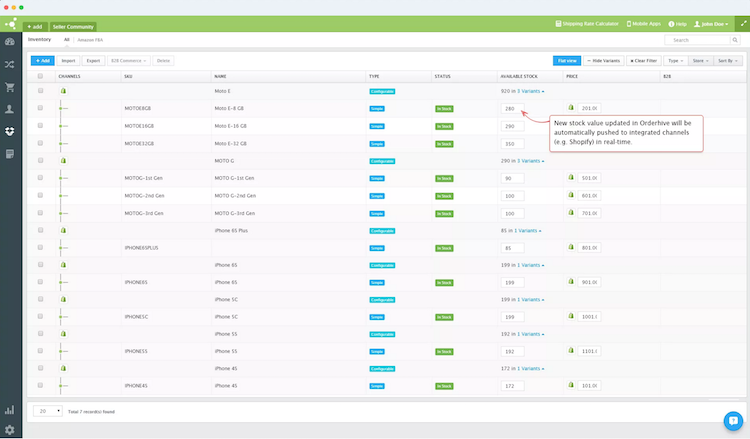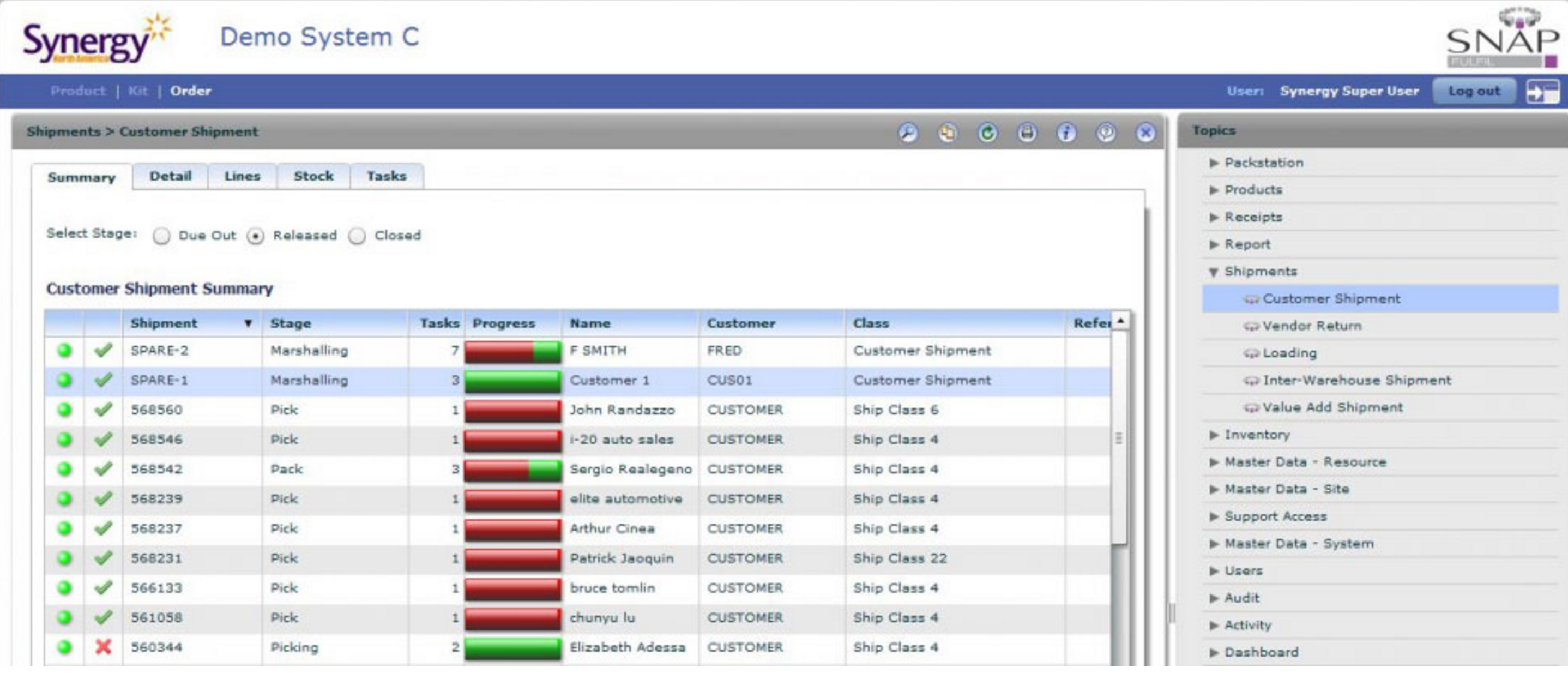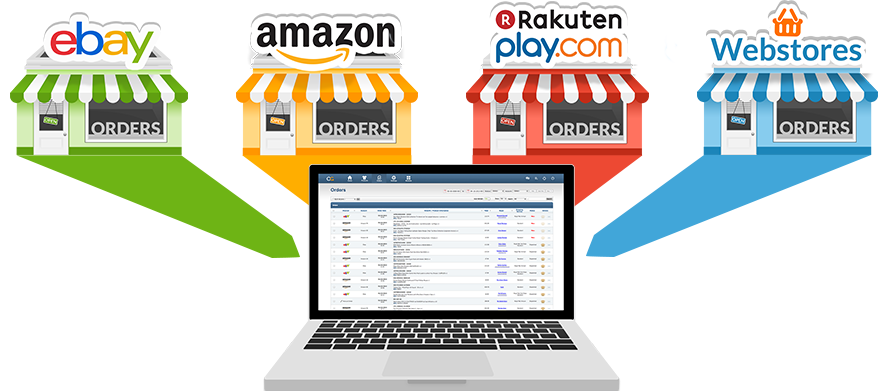Find the best Order Management Systems
Compare Products
Showing 1 - 20 of 531 products
Sort by
Reviews: Sorts listings by the number of user reviews we have published, greatest to least.
Sponsored: Sorts listings by software vendors running active bidding campaigns, from the highest to lowest bid. Vendors who have paid for placement have a ‘Visit Website’ button, whereas unpaid vendors have a ‘Learn More’ button.
Avg Rating: Sorts listings by overall star rating based on user reviews, highest to lowest.
A to Z: Sorts listings by product name from A to Z.
Precoro
Precoro
Precoro is a cloud-based purchasing software that streamlines procurement processes for SMBs and Enterprises. Key features include purchase order creation and delivery, blanket PO, visual analytics on spends by departments, billin...Read more about Precoro
monday.com
monday.com
monday.com is an award-winning work and project management platform that helps teams of all sizes plan, prioritize, manage, and execute their work more effectively. The platform offers solutions for a wide range of use-cases such...Read more about monday.com
Zoho Inventory
Zoho Inventory
FrontRunners 2024
Zoho Inventory is a cloud-based inventory management solution designed for small to midsize businesses. It features inventory management modules including reporting and analysis, vendor managed inventory and lot traceability. It f...Read more about Zoho Inventory
Oxalys
Oxalys
Oxalys assists businesses in streamlining procurement processes. Oxalys is the preferred partner of mid-sized organizations from various industries in more than 25 countries across the world as a software vendor focused solely on ...Read more about Oxalys
Salesforce Commerce Cloud
Salesforce Commerce Cloud
Salesforce B2C Commerce is a cloud-based order management solution that enables businesses to streamline processes related to marketing campaigns, merchandising, order fulfillment and more. Professionals can improve social outreac...Read more about Salesforce Commerce Cloud
EZRentOut
EZRentOut
EZRentOut is a cloud-based equipment rental solution that caters to businesses across various industries such as construction, event management, IT, sports and more. Features include contract management, inspection management, med...Read more about EZRentOut
Procurify
Procurify
Procurify’s easy-to-use Intelligent Spend Management platform provides hundreds of organizations worldwide with real-time visibility and control over all business spend. By bringing more spend under management, our customers captu...Read more about Procurify
Enterpryze
Enterpryze
We are the no.1 Inventory Platform for SMEs, a cloud-based ERP that helps small and medium-sized businesses (SMEs) maximise their margins. We make selling your products easy with our easy-to-use, powerful, cloud platform, which ...Read more about Enterpryze
QuickBooks eCommerce
QuickBooks eCommerce
FrontRunners 2024
QuickBooks Commerce is a powerful cloud-based inventory and order management software for modern online businesses. Seamless integration across all major e-commerce platforms ensures that product listings, orders, and data stay up...Read more about QuickBooks eCommerce
SCExpert
SCExpert
SCExpert by Made4net is a cloud-based supply chain solution that helps organizations in the movement, tracking and management of inventory and documents. The solution consists of discrete processes that include ordering, transport...Read more about SCExpert
Da Vinci Supply Chain Business Suite
Da Vinci Supply Chain Business Suite
Da Vinci is a cloud-based supply chain management (SCM) solution designed specifically for 3PLs, internet retailers and wholesale businesses with demanding warehouse, fulfillment and transportation needs. In addition to a WMS an...Read more about Da Vinci Supply Chain Business Suite
Claritum
Claritum
Claritum is a cloud-based spend management solution designed to streamline source-to-settle processes for midsize and enterprise-level organizations. From source to settle, organizations have an automated process to capture o...Read more about Claritum
Acctivate Inventory Management
Acctivate Inventory Management
Built for growing product-selling businesses using QuickBooks, Acctivate is a premium inventory management & multi-channel order fulfillment add-on that helps you focus on growth without operational limitations. Solve for QuickBo...Read more about Acctivate Inventory Management
Ramp Enterprise WMS
Ramp Enterprise WMS
Enterprise WMS and Interchange EDI by Ramp Systems is a warehouse management system (WMS) that provides tools for both asset-based and non-asset-based 3rd party logistics (3PL) companies. The software has a report writer feature t...Read more about Ramp Enterprise WMS
Bellwether Purchasing Software
Bellwether Purchasing Software
FrontRunners 2024
Bellwether Purchasing Software is an easy-to-use, cloud-based purchasing and inventory management solution ideal for SMB customers in all industries who create 50-1000 POs a month. Primary features include requisitions, approval ...Read more about Bellwether Purchasing Software
Circle Commerce Manager
Circle Commerce Manager
Circle Commerce Manager is an omnichannel, cloud-based order management solution. This modular solution handles aspects of accounting, forecasting and reporting, as well as shipping and selling channels through eBay and Amazon. ...Read more about Circle Commerce Manager
RapidResponse
RapidResponse
Delivered as a set of configurable applications, Kinaxis RapidResponse is a supply chain management solution that helps large enterprises and logistics service providers with planning and execution. Kinaxis offers organizations th...Read more about RapidResponse
Brilliant WMS
Brilliant WMS
Brilliant WMS is a cloud-based platform that centralizes customer information into one interface. The software is used to manage and streamline different aspects of warehouse management and is used in many industries including man...Read more about Brilliant WMS
Tradogram
Tradogram
FrontRunners 2024
Tradogram is a cloud-based procurement management solution. Users can choose from a list of integrated modules such as supplier management, purchase-to-pay, contract management, strategic sourcing and order management. Team manag...Read more about Tradogram
Lead Commerce
Lead Commerce
Lead Commerce is an integrated order management suite that offers applications like inventory management, merchandise planning, and customer relationship management. The solution helps small and midsize businesses streamline and a...Read more about Lead Commerce
Popular Comparisons
Buyers Guide
Last Updated: March 16, 2023Managing inventory is an important job in any company that sells and ships goods. Making sure orders are accurate and delivered on time is vital to keeping customers happy. Therefore, it’s important to strive for a “perfect order” every time.
That’s where an order management system (OMS) comes in. OMS software gives supply chain managers a bird’s eye view of open orders, available inventory, payment and delivery status and more. Managers can use this information to identify potential problems and optimize processes to keep purchasing and fulfillment running smoothly.
If you’re considering an order management system for your business, this guide is for you. Here’s what we’ll cover:
What Is Order Management Software?
Who Buys Order Management Software?
Common Order Management Functionality
Potential Order Management Software Benefits
What Is Order Management Software?
Order management software supports order entry, processing and fulfillment of orders from the point of purchase through payment and delivery.
Businesses that use this type of system have:
Access to customer, vendor and purchase order records.
A real-time overview of available inventory quantities and locations.
The ability to set rules so the system determines the best way to source orders based on inventory location and availability.

Inventory quantities, types and status for Orderhive
Who Buys Order Management Software?
Retail companies are the primary purchasers of order management systems. Multichannel retail businesses are complex, often dealing with a large number of suppliers, warehouses and fulfillment channels.
Companies in industries that manage supply chain demands also benefit greatly from the added efficiency this type of software brings. These industries can include:
Health care
Food distribution
Manufacturing
Transportation
Order management is useful for any size B2C, B2B or wholesale company. This can include anything from small e-commerce companies processing single units at a time to large enterprises filling orders of thousands of units.
Common Order Management Functionality
Order management applications are diverse. Some vendors offer integrated suites with a large number of modules, while others specialize in one or two particular functions. Most, however, include the following core functionalities:
Customer database | A customer database is, as the name implies, a database for customer information. At the very least, it will store customer and vendor data, current and past orders, delivery receipts, invoices and payments. The more customizable the system, the more types of data a business can store. |
Gives managers the tools to import and maintain catalog content. Some products allow suppliers to manage and revise items themselves, so the content is always accurate. Other features may include revision tracking, automatic categorization, taxonomy management and user access/privilege control. | |
Works to manage inventory levels, track shipping costs, identify trends and more. This makes it possible to forecast and optimize inventory planning strategies. | |
Order fulfillment and tracking systems track unpaid orders and streamline the entire fulfillment process. Systems use rules and algorithms to review orders and determine the most efficient way to fill them. |

Order fulfillment details in Snapfulfil
Potential Order Management Software Benefits
Businesses that choose the right OMS can realize several key benefits. Most commonly, an OMS will help users to:
Speed order processing. With greater visibility of the order-to-delivery cycle, it’s possible to find bottlenecks and improve the process.
Reduce back orders and delays. Since inventory data is always up-to-date, managers can predict shortages and make plans to circumvent them. An OMS also simplifies reordering, so it’s easier to maintain optimal inventory levels.
Improve customer service. Greater overall efficiency and an error-free order-to-delivery cycle naturally leads to more satisfied customers. At the same time, customers can know the availability of items in their order.
Market Trends to Understand
As e-commerce and automation become more important to businesses, be sure to keep these current trends in mind when choosing an OMS:
Businesses are looking for a unified omnichannel management system. A unified omnichannel business management system is capable of managing customer interactions and information, updating warehouse inventory, accessing accounting information, managing the retail order supply chain and much more.
Nowadays, businesses are looking for integrated suites that not only automate the entire order distribution process, but can also help manage in-house inventory, monitor retail point of sale, control warehouse operations and coordinate with logistics providers via a single integrated solution. Such unified offerings help businesses manage multiple operations from a single platform.
Demand for integrated solution increases. Most small and midsize OMS vendors are not capable of providing unified suites that can offer multiple capabilities within a single solution. In such cases, they provide a suitable integration tool or an application programming interface (API) for integrating the solution with other business applications, such as customer relationship management (CRM), enterprise resource planning (ERP), business intelligence and transportation management systems.
Even businesses having separate applications for different operations give preference to solutions that can offer seamless integration with other in-house systems and applications. This kind of an integrated architecture streamlines the flow of information between applications and provides a scalable environment in which new applications can be deployed and connected to the existing network easily.
Many businesses also look for an OMS solution that can integrate with various e-commerce websites, such as Amazon and eBay, for selling products directly through these channels.

Multichannel order processing in ChannelGrabber
Rise in demand for cloud-based offerings. More and more OMS software vendors are upgrading their solutions from on-premise to cloud-based deployment models. In cloud-based deployment, the hardware and supporting infrastructure is hosted on the vendor’s premises, and users access the interface through a web browser via any internet-enabled device. Such a deployment model benefits both software providers and end users in terms of cost, centralized system management, fewer network errors and enhanced solution scalability.
Vendors can also host their applications on third-party cloud service providers, such as Amazon, Microsoft and Google, and further reduce their service prices so end users can manage their orders and inventory at a lower cost. Such a model also saves end users from the trouble of software and hardware installation.
Mobility. Users are giving priority to mobile-friendly solutions that are easy to access on tablets and smartphone devices as well as desktops and laptops. Such mobility enhances users’ productivity in tracking business operations on the go. Most order management solutions come with dedicated mobile apps that are compatible with different mobile operating platforms including Android, iOS and Windows. These apps not only help businesses streamline the entire quote-to-order process but also improve the overall user experience by providing all order-related information on their fingertips.
Big-data analysis. Most businesses are looking for solutions that can analyze the huge chunks of data collected from multiple data points during customer interactions and order delivery. Such analysis helps businesses generate suitable insights regarding demand forecasting, improving forecast accuracy, reducing forecast errors and studying customer behavior. It also helps in order capacity optimization, especially when a business has multiple product offerings.







